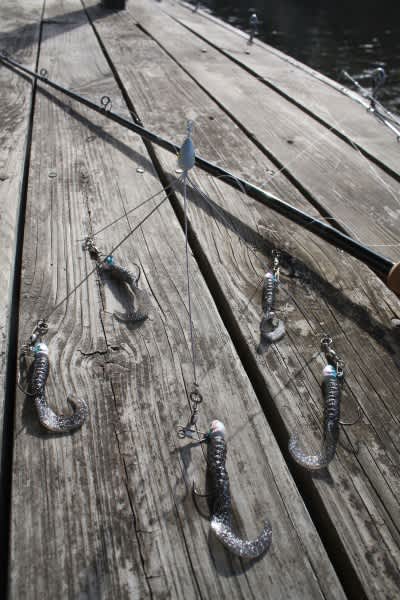Rigged for a Reservoir, Bass in the Rangefinder
OutdoorHub 01.25.12

Pretty clichéd, but having the “right tools in the toolbox” applies to pretty much every outdoors endeavor. Whether it’s dry matches and an air mattress for camping or a sharp fillet knife and fish batter for a shore lunch; having the right tools for the task makes all the difference.
A couple months back, I took advantage of an invite to chase an array of species on a southern reservoir – Lake Ouachita in Arkansas, to be exact. I would have the opportunity to fish for largemouth bass, Kentucky spotted bass, crappies, bluegills, walleyes, catfish, and even inland stripers. Not knowing what we’d be targeting at any given time, I loaded an array of fishing gear to cover all of my options. And did I mention out of a brand new boat on its maiden voyage? This was truly a multi-species undertaking with all the fixings.
The new Lund Impact 1875 was loaded to the hilt, as I motored south of the Mason Dixon Line. But it was clear right out of the shoot that we’d be on bass first. My sidekick, Arkansas angler and outdoor writer Jason Sealock called the shot. He’s a bonafide basshead – I wasn’t going to put up a fight, knowing what swam these seas. And being in the realm of reservoirs, and during a cold water period – water temps in the 50s and 60s – Jason knew the river channel was going to play big. And it did.
Bass, largemouths and spotted, stair-stepped all along the deep channel breaks. No such thing as too steep, either. Fish were glued to the sheer stuff. Further qualifying spots, we focused on sharp channel bends nearest shoreline bluffs, where the channel swung in and ricocheted back out. Bass were concentrated at both the head and tail of the channel hook. So, once that discovery was made, it was simply a matter if identifying similar situations throughout the reservoir.
Lowrance’s new structure map feature allowed us to quickly, and I mean quickly, layout underwater terrain on our contoured map, showing us exactly where the fish were holding and primary areas to cast. Being on an unfamiliar body of water, this new structure map feature instantly revealed some key fish holding areas that conventional sonar would undoubtedly miss. This feature is a must-have for anglers that like to explore new bodies of water.
The thrifty process of elimination landed us right on fish. So next was to determine what flipped their switches. Pre-rigged on the deck of the Lund Impact was a quadrant of presentations, both on spinning and baitcasting combos. A tug-of-war ensued seeing who would get their hands on the “umbrella rig,” or “Alabama rig” (the latest bass fishing phenomenon). I won, clutching St. Croix Rods’ new Rage harnessed to what ended up being the smaller umbrella rig. (Jason went and upsized everything on me – such defiance. But, as it turned out, my less gaudy umbrella rig smacked the most fish anyway.)
The Alabama rig consists of a splay of five wire arms that have swivels attached to the end of each. Fishermen can connect a variety of baits like grubs or soft plastic jerkbaits, which will imitate a school of baitfish on the swim. Just any old rod in the boat isn’t up for throwing a chandelier with hooks, either. The size and weight of an umbrella rig will give you a real workout if not matched with the correct rod. The St. Croix Rage Casting MH 7’ performed like it had been trained for the task. It stayed balanced with the heavy rig and at the same time didn’t wear out my arm like I’d hurled 100 fastballs.
Without question, the umbrella rig enticed the biggest fish. But we did keep a variety of other presentations rigged and ready, including lipless crankbaits, finesse jigworms, and jigs with soft plastics. We stationed the entire selection at a moment’s notice on the front deck. And speaking of that deck, the Lund Impact fishes like a bass boat, with the casting platform level throughout the entire boat. Muskie casters will appreciate the design as well. Again, the Impact is picture perfect for multispecies angling.
Another effective presentation was burning lipless crankbaits across the channel breaks. The Rapala Clackin Rap, Northland Rippin Shad, and the Strike King Red Eye Shad proved to be the right tools in the toolbox. North or South, I am certain that there isn’t a bass that swims that won’t eat a tight-wobbling lipless crankbait.
Having only limited time, I wasn’t able to take full advantage of Lake Ouachita’s wide variety of fish species. But, having the opportunity to chase everything from crappies to stripers certainly makes for high excitement, and having the ability to carry so much gear in one boat puts your mind at ease no matter what fish you cross paths with.
Lake Ouachita offers up a smorgasbord that any multispecies angler can truly enjoy!

